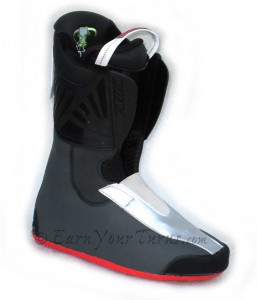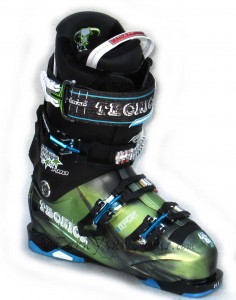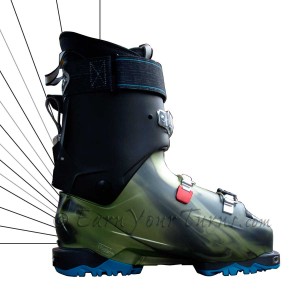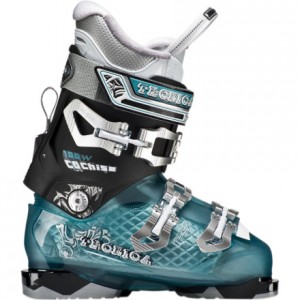Of the many variations in the Cochise family, my fave is probably the Cochise 110. Mind you I haven’t tested it, per se, but my time in the Pro Light with a flex rating of 130 suggests the 110 would be more to my liking. If you like a stiff flexing boot the Cochise Pro 130 or Pro Light will probably be right up your ally, especially if you tip the scales in the 200+ pound (90 kg) range. Aside from the flex of the cuff, the Triax plastic lower shell insures there is no rotational loss of control with the Cochise, yet it is relatively easy to modify if you have a foot that demands a bit of punching or grinding.

The Pro liner sports plastic reinforcements on the cuff and a rubberized sole for walking around sans shell.
A strict count of the buckles suggests only three in combination with a velcro power strap. However, in the womens 100 flex version, and mens 110, 120 and Pro 130 version the power strap is enhanced with a buckle that yields a smooth but tight grip around your lower leg. A side benefit of the buckled strap is how easy it is to flip open to allow for more range of motion when the cuff is switched to walk mode.
The Pro 130 walks well with a solid 10° of rear cuff motion. Admittedly it can’t compete with the rear motion of a rando race boot, but it makes walking a dry trail noticeably more comfortable than many sidecountry boots that retain a bit of franken-stride, like Garmont’s Prophet.
The walk mode switch is a solid metal-to-metal latch which delivers a healthy 3-point contact between the cuff and lower shell. It is very rigid and will not yield beyond the prescribed angle – 16° – without serious force. Too much for me, maybe not for you. It would be nice if the forward lean angle could be easily increased, but Tecnica only provides one locking position, and moving it will require tools, time and skill.
My only serious complaint is with the Cochise Pro Light. It comes with a tongued, heat-moldable Palau brand liner that has some nice features (higher density foam in cuff and L-pads around the heel) but is rather thin. That isn’t my biggest gripe though; dropping the buckle on the power strap is. Tecnica’s excuse is they wanted to save 40 grams on the buckle to keep it a “lightweight” boot. Nonsense! Those 40 grams add way more power than weight and besides, if you really were trying to make a light weight boot that competes with rando light AT boots you’d need to shave a lot more than 40 grams not to mention the already nice walk feature would have to get better too. The good news is the holes for the buckle are already molded in to the cuff and with a $40 set of buckles and a bit of McGyvering you can convert the plain velcro power strap into a more powerful and functional buckled version.
As long as you recognize the Cochise won’t win any lightweight awards I’d say stick with the Pro 130, 120 or 110. Even though the liner for these models is heavier than the heat moldable Palau, it is more comfortable and improves a downhill performance more on par with a full alpine boot. Besides that, it comes with a nice rubberized sole for hanging around in a hut, something absent in the anemic Palau liner.
Fitwise the Cochise favors those with a medium to high instep, and a medium width forefoot. My pancaked foot needed a full 6mm tongue shim to stay seated in the shell, but otherwise fit well after a bit of heat molding. I’ve seen a lot of happy feet this season wearing Cochise boots. If you’re in the market for an AT boot that regularly crosses boundaries be sure to stick your foot in one.
Tecnica
Cochise Pro 130
MSRP: $750
Weight/pr.: 9.2 lbs. (4.2 kg) (mondo sz: 27.5)
Size range (mondo): 25.0 – 31.0
Cochise Pro Light
MSRP: $800
Weight/pr.: 7 lbs., 6 oz. (3.4 kg)
Cochise W100
MSRP: $500
Weight/pr.: 8 lbs., 14 oz. (4.02 kg)
Related Posts
Sierra Descent’s review of Cochise Pro Light
Lou’s view
© 2013




1 comment
6 pings
I’ve got to try a pair of these!
[…] The Cochise will continue on as is since there is so little need for fixing. In the case of the Cochise Pro 130 I would agree there is little to change. However, the Pro Light would benefit greatly by […]
[…] moves aft about 15°+. Certainly not as flexible as Dynafit’s TLT5, but better than a Cochise or K2′s Pinnacle. In skinning mode there is more than enough range of motion to travel […]
[…] Since Tecnica’s Cochise has been on the market longer, it is easier to get a buckle from the Cochise Pro power strap. If you can, get the strap too since it has a ready made, one sided attachment system […]
[…] who have been in the game a bit longer, like Tecnica’s Cochise and Salomon’s Quest series fared better, offering boots that not only offered a walk mode, […]
[…] Posts Review: Tecnica Cochise […]
[…] EZ-Lock® ladders Garmont abandoned (probably due to cost) and a buckled power strap, ala the Cochise or Pinnacle? That would add some pizzazz to this functionally versatile […]